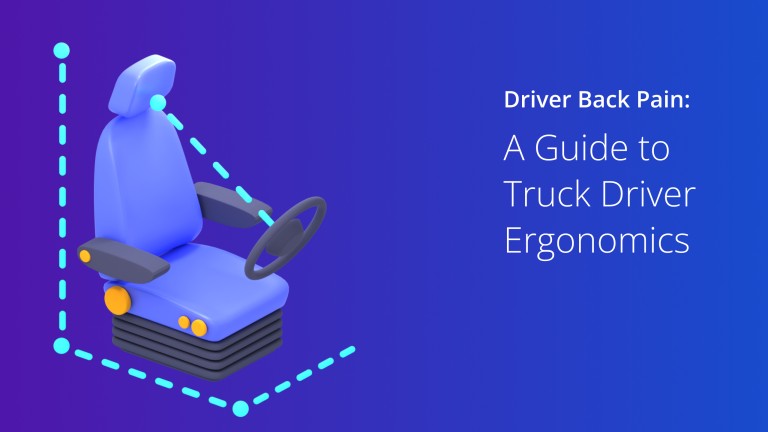There’s a lot to love about being a truck driver—the open road, seeing different places, and experiencing life as an independent traveler.
But the reality is that truckers spend lots of time behind the wheel, which comes with many fleet safety concerns. When you’re sitting in the same position for hours on end, good seat ergonomics are essential to your comfort, health, and ability to focus on the road.
This article will give you everything you need to know about ergonomics, why it’s especially crucial for trucks, and what you can do to stay comfortable and safe on the road.
Truck Route Navigation App

Table of Contents
What is Ergonomics, Exactly?
In a broad sense, ergonomics is defined as the science of designing and providing a comfortable working environment for people. In other words, it’s about making sure our workspace (or, in this case, the truck seat) suits our body size, shape, and needs.
For truckers specifically, ergonomics is all about finding ways to make long trips more comfortable, so you can stay alert and focused. Good ergonomics means having the right seat position and posture to reduce fatigue, prevent injury, and promote driver safety. Proper seating positions should also ensure you have a clear view of mirrors and allow for
easy access to controls.
Why is Ergonomic Seating so Important?
Have you ever driven for a few hours and started feeling stiffness and back pain? Or, worse yet, neck or shoulder pain that lasts for days afterward?
Most of the time, you can stop at a gas station, stretch quickly, purchase a snack, and move on with your travels. And if nothing is around, you can pull over for a minute.
But commercial truck drivers have places to be and times they need to be there. Of course, a good manager won’t force you to drive long distances if you’re in pain—they’d rather you get out and stretch for a moment. But it’s best to avoid any discomfort or injury in the first place.
Commercial trucking is a dangerous occupation from all angles.
Source: Bureau of Labor Statistics 2022 Report
Trucking is one of the ten most dangerous occupations in the US. Last year, the US Bureau of Labor Statistics reported a 16.3% increase in the occupational fatality rate for truckers.
This isn’t just because truckers drive long distances. Being a commercial trucker comes with several responsibilities:
- Making safe, efficient deliveries on time.
- Loading and unloading heavy cargo.
- Ensuring your equipment is in good working order.
- Maintaining a clean and safe work environment.
Within these responsibilities, there is plenty of room for something to go wrong.
There were over 5.2 million police-reported motor vehicle accidents in 2020, according to the most recent data from the National Highway Traffic Safety Administration (NHTSA). And millions of people injure themselves lifting heavy items every year, whether for personal or occupational purposes.
So when truckers clock in for work, the odds are against them—they repeatedly perform activities that millions of regular people injure themselves doing. And they do it for hours at a time.
Proper ergonomics can help prevent common truck driver injuries.
We can lump most trucking-related injuries into two main categories: musculoskeletal injuries and motor vehicle accidents.
As a driver, you risk sustaining an injury that could have been prevented by good ergonomic practices.
- Sitting too close to the steering wheel might result in long-term neck, shoulder, and back pain from prolonged time spent behind the wheel.
- Pushing, pulling, and lifting heavy objects can result in neck and back injuries, particularly after sitting for long periods.
- Poorly positioned seats can cause you to strain your eyes, lose focus, and cause potential traffic accidents.
Of course, ergonomics can’t fix all causes of injury (e.g., driving while intoxicated, distracted driving, etc.), but it can help reduce the risks associated with long-distance trucking. Making minor adjustments in posture, positioning, and overall seating comfort can significantly reduce your risk of workplace-related injuries.
The Benefits of Truck Driver Ergonomics
For a regular driver, comfort in the car is essential, but for truckers who drive for extended periods of time, comfort and proper ergonomics are critical.
There are several benefits to following proper ergonomics while driving:
1. Prevents common commercial trucker injuries
The inherent risks of lifting and transporting heavy objects and driving long distances can take a toll on your body if you don’t take the necessary precautions. And that’s where ergonomics come into play: proper ergonomic seating can help prevent common truck driver injuries.
Ergonomic seating provides lumbar support, which helps to support your spine and reduce the strain on your back muscles. It also helps promote good posture, which can help prevent neck and shoulder pain. That way, when truckers get out of the cab to lift and carry cargo, their back muscles are already in a better place to handle the strain.
2. Reduces the risk of long-term health problems associated with trucking
Truckers who grip the steering wheel or shift gears for long periods of time are at risk of developing carpal tunnel syndrome and arthritis. The added back strain associated with poor posture and heavy lifting increases the risk of long-term musculoskeletal problems like sciatica and herniated discs.
The earlier in life your neck, back, and joints lose their function, the greater your chances of developing chronic pain and illnesses. And that means costly surgeries, corrective physical therapy, and mobility aids.
Ergonomic seating can help truckers maintain good posture, reduce strain on joints, and avoid long-term health problems like carpal tunnel syndrome by giving them the support they need to remain comfortable and focused on the road.
3. Improves safety while driving
Many occupational health and safety risks are associated with truck driving, from fatigue to impaired vision. Ergonomic seating can help minimize these risks by promoting better posture and comfort while on the road.
With a more comfortable seat, you’ll be less likely to slouch or hunch over as you drive for long periods of time. That way, your body will stay in its natural position, allowing you to be more alert, aware of your surroundings, and less prone to drifting off.
Additionally, proper ergonomics can help reduce distractions while driving. A comfortable seat allows truckers to focus on the road for longer without taking frequent breaks or writhing in discomfort.
4. Enhances physical and mental well-being
For fleet managers and businesses, driver satisfaction and productivity are critical to an efficient operation. An excellent delivery experience starts with the person making it happen: the trucker.
And since driver shortages and retention are two of the top issues companies face, it’s in everyone’s best interest to ensure drivers are comfortable and safe on the job.
Ergonomic seats positively affect driver morale and physical well-being by decreasing driver fatigue and improving concentration. Since they offer lumbar support and adjustability and encourage good posture, they help truckers arrive feeling more energized and refreshed.
Plus, ergonomic seating can help keep driver alertness and reaction time at peak levels, which is essential for safety on the road.
5. Fewer concerns for fleet managers
Safety, compliance, and driver satisfaction are always top-of-mind for fleet managers with items including:
- Truck and workplace maintenance
- Dispatching and scheduling
- Driver safety, training, and qualifications
- Budgeting, fuel costs, and other expenses
- Sustainability policy and environmental regulations
- Corporate compliance and regulatory requirements
Ergonomics isn’t a cure-all, but it can take some guesswork out of driver safety and satisfaction.
From a compliance standpoint, ergonomic seating solutions help fleet managers reduce the risks associated with hours-of-service violations and driver fatigue.
Ergonomic seating also helps prevent workplace injuries by supporting back muscles weakened from long hours of sitting in an uncomfortable position. Fleet managers can also rest assured knowing their drivers are comfortable and safe on the job.
How to Optimize Truck Driver Ergonomics
Ergonomics is about more than just purchasing the right seating. Here are a few tips for optimizing truck driver ergonomics:
1. Provide adjustable seats with lumbar support.
If you want your drivers to stay comfortable and alert throughout their shifts, adjustable seats with lumbar support are a must. This provides the perfect balance between comfort and ergonomics.
There are a few things you should look at when testing out seats:
- Backrest: Backrests should be adjustable and provide full lower back support. Drivers should be able to move the backrest to a point where their spine is in proper alignment and
adjust the center curvature to fit their lumbar arch. - Headrest: Headrests should be adjustable so drivers can move them up or down, depending on preference. This ensures good neck and head support when driving long distances.
- Seatpan: The seat pan should be deep enough to support the driver’s legs without leaving them dangling off the edge. It should also be wide enough for the driver to shift
positions without feeling too cramped. Look for a gel seat cushion for added comfort and support if possible. - Armrests: Armrests should be adjustable so drivers can move them up or down to the most comfortable position.
- Tension Control: Drivers should be able to adjust the pressure they feel in the seat while driving. This helps ensure their body is not overworked or uncomfortable
during long trips. - Adjustability: The seat should be able to slide forward and backward depending on driver needs. That way, they will be able to comfortably reach the wheel while operating their
vehicles.
2. Make sure seats and pedals are positioned correctly.
The ideal pedal and seat positioning will depend on the driver’s size. It should be adjusted so that the driver can reach the gas pedal without strain or overextension of their legs.
Make sure to adjust the seat so it’s at a comfortable height for the driver. This helps reduce fatigue and promotes better posture.
3. Encourage drivers to move around during stops or rest periods.
Moving around during breaks and rests allows commercial truck drivers to maximize the benefits of improved ergonomics while on the job. Not only are standing and walking good for your posture, but they also help keep your muscles from getting weak or stiff.
Drivers should be encouraged to move around during their rest periods, even if it’s just for a few minutes. This can help break up long hours of sitting in the same position and will improve overall comfort and productivity.
4. Invest in a steering wheel cover.
Believe it or not, a steering wheel cover can help make the driver more comfortable. A good steering wheel cover will provide cushioning and support, reducing pressure on your hands and wrists. It also reduces the impact drivers will feel when the truck vibrates from the road.
5. Maintain good habits outside the workplace.
Even when at home, it’s essential to maintain healthy habits. Practicing yoga or Pilates can strengthen your core area, which will help protect the neck, back, and spine during driving sessions.
When sitting at home, in a hotel, or at a restaurant, it’s important to always sit up straight and keep your feet flat on the floor. This further helps relieve any strain caused by long hours of sitting in an uncomfortable position.
If you have persistent pain or discomfort, you can also perform exercises specifically for your lower back and neck muscles to build strength and rehabilitate those areas. And if the pain becomes unbearable, it is best to seek medical attention.
6. Educate drivers about ergonomics best practices.
To ensure driver safety and satisfaction, the best thing you can do as a fleet manager is relay the importance of following ergonomic best practices. Educate drivers on proper posture, how to adjust their seat and rest periods, and the long-term benefits of taking small steps to increase comfort.
Here are a few general tips and best practices to train them on:
- Always wear your seatbelt
- Adjust the steering wheel and mirror to a comfortable position
- Configure your mirrors properly
- Sit in a neutral position, with your feet flat on the floor
- Take regular breaks
- Stretch during rest periods
- Make sure your seat is adjusted correctly
Poor ergonomics can cause health issues and put company drivers at an increased risk of injury. By reminding them of the importance of comfort and giving them the resources to properly maintain it, you can minimize the risk of injury and maximize productivity.
7. Provide regular training on truck ergonomics and safety.
As a part of your training curriculum, make sure to include ergonomic and safety information. This should cover topics like proper seat positioning, how to reduce fatigue, and the importance of taking regular breaks. Doing so will help drivers understand the benefits of properly maintaining their comfort and its importance for their overall health.
By providing this information, you can create a safe working environment that will protect your drivers and ultimately improve the success of your fleet.
8. Invest in driver-focused technology
Technology plays a vital role in trucker ergonomics as well. Using commercial vehicle and truck route optimization software like Route4Trucks helps drivers optimize their trips so they can
minimize the time spent on the road.
Using reliable truck routing software, fleet managers can create routes that are optimized for driver comfort, reducing the time they spend on each trip and allowing them to take more rest periods.
Along with this, it can provide helpful insights into drivers’ overall performance so fleet managers can take proactive measures to improve their comfort, satisfaction, and safety.
Want To See For Yourself How Route4Trucks Can Make Your Driving Safer?

Frequently Asked Questions (FAQs) about Driver Back Pain
Is truck driving hard on your body?
How do truck drivers stay comfortable?
What should fleet management include in truck driver training material?
What technology can help improve ergonomics for truck drivers?
their comfort and safety.
Key Takeaways
The key to creating a comfortable and productive experience for commercial truck drivers is an ergonomic approach. This means familiarizing yourself with the best practices, investing in technology that will help optimize routes and increase driver satisfaction and providing regular training on safety and ergonomics.
Using trusted, reliable, and fastest route planning software, drivers can create optimized routes for comfort, helping them reduce the time spent on each trip. And fleet management can take a proactive approach to fleet and workforce management.
With a few clicks, you can create a safe and comfortable working environment that will benefit your drivers and your business.







